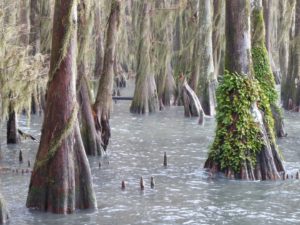
When people are asked about memorable childhood experiences in nature, time spent with or in a special tree is often mentioned. In my beloved grandmother’s backyard there was a wide-spreading sugar maple that was also, somehow, my grandmother. This was a mystery that I could never understand rationally, although I tried hard to think about it. I just knew that my grandmother and the tree were one and the same. Sensing the truth of their inseparability, I glimpsed the existence of another level of reality quite different from the ordinary one. The maple tree’s nourishing presence sustained me throughout a difficult childhood. Many of us have formed strong attachment bonds to certain trees, sacred trees, that continue to be profoundly sustaining memories. For some people an affectionate relationship with a tree is the doorway into a lifelong love of nature. My husband and I have planted countless trees to restore our small woodland, and I imagine the desire to do so has something to do with wanting to give back, in gratitude, to my childhood tree.
The Rag Tree

That sugar maple opened me to a secret feeling that trees are sacred beings, but I never heard of trees being venerated as sacred in any areas of this country that I lived in as an adult. When my husband and I began making pilgrimages to Ireland, I was especially drawn to her holy wells. There are often sacred trees standing by these healing springs. Tree and well seem inseparable. At some holy wells it is traditional to ask for a blessing by dipping a piece of cloth in the water, touching it to the place on the body that needs healing, and hanging the cloth ribbon from a branch. It is said that by the time the cloth returns to the elements, the tree will have absorbed the ailment and healing of mind or body will be complete. We have tied many a cloth prayer for healing for friends and family to such “rag trees.” In Scotland the word for cloth is clootie, so such trees are called “clootie trees.”
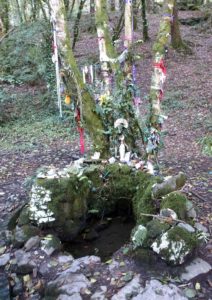
On one of our first trips to Ireland we travelled to the extreme southwest to visit the territory of my O’Driscoll ancestors. At Lough Hyne we hiked through the woods on the side of the hill to two holy wells I’d read about and fervently wanted to find. One was a small spring called Tobar na Sul, Little Well for the Eyes, with its multi-trunked tree. Further on, the other well Tobar na Sceabhrach, the Well of the Slope, originally dedicated to St. Ina after whom the lake was named, is now attributed to Mary and is known as Skour Well. They were both exuberantly and pleasingly decorated with devotional ribbons and iconic objects. Bringing with me my American mindset, I assumed that those ribbons tied to the trees would be seen as rather “airy fairy,” even by the Irish. But when we visited the Skibereen Center, which had been built to commemorate the great Famine that was especially devastating in that area and also to showcase the tremendous biological diversity in Lough Hyne, a unique marine lake, I was profoundly moved to see huge wall-size photographs of those holy wells with their decorated trees mounted proudly. Watching a film on Lough Hyne in which a man recounts memories of his grandmother taking him to a Mass at Skour Well every Bealtine, the beginning of spring, I cried.
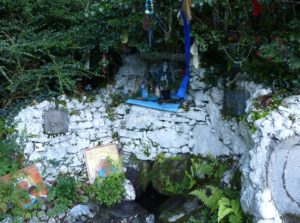

In Ireland we leave offerings of gratitude to the waters and to the trees for their healing, and for bringing us wisdom. The ancient Irish honored and protected sacred trees, Bili. Irish myths about hazel trees surrounding the Well of Wisdom form part of the fabric of Irish consciousness. (See Hazelnut Wisdom for a story about my ongoing mystical relationship with hazel trees.) Honoring trees as sacred fulfills a deep desire in me to bless and be blessed by trees. The child in me knows this to be a true and necessary act of love.
The impulse to venerate trees is probably world-wide. I have seen photographs of trees in Turkey called “wishing trees” practically covered with cloth prayer strips, and pictures of prayer flags hung on trees in the mountains of Tibet where the wind blows the prayers out to all the benevolent spirits. I have had transformative dreams of trees, one of which was very much like the Buddha’s Bodhi Tree under which he sat and gained enlightenment. Buddhist monks in Thailand and Cambodia are ordaining trees, marking them as being practitioners of the sacred by tying bright orange ribbons around them to save them from destruction. In springtime old European cultures honored a sacred local birch tree standing in a clearing in a grove by decorating her with flowers and colorful ribbons, perhaps the origin of the Maypole dance. Honoring sacred trees is a world-wide and ancient human impulse.
But in this country when and where do we honor trees as sacred? We cut an evergreen tree and decorate it at Christmas to symbolize everlasting life, for which we are indeed grateful. The Christmas tree is an aspect of the rich and nourishing symbolism of the Tree of Life, the Cosmic Tree, the Axis Mundi joining heaven and earth. But symbols are not living beings. Where and when do we, in this profoundly matter-and spirit-separated culture, honor living trees? We may measure individuals of each species and celebrate them as champion trees for achieving their great size, but many of these are out in fields, not even contributing to the ecological processes of a forest.
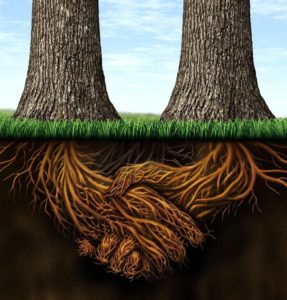
That may be changing. Trees are gaining more respect. We are now being given permission to celebrate living trees in forests as sentient beings. There are quite a few books out popularizing new research on the interconnecting web of relationships in which trees support and nourish each other through their fungal partners’ mycelium threads which connect their roots to water and soil nutrients. Trees share these nutrients with relatives and friends, even with neighboring trees of a different species. People are expressing delight and amazement reading about this “wood-wide web.” But we continue to cut down whole forests of huge old trees, like redwoods in the west, bald cypresses in the east. Finally, some foresters are beginning to realize that there is hardly any old growth left. Scientists are trying to warn us that intact forests are critical for biodiversity and for sequestering carbon, the release of which, through cutting down forests for agriculture and development, is a major contributor to climate change. My heroes are people who are conserving forests, rewilding landscapes, bringing the chestnut back to life. We understand that this is an environmental issue, but is it seen as a spiritual issue?
The Rock Tree
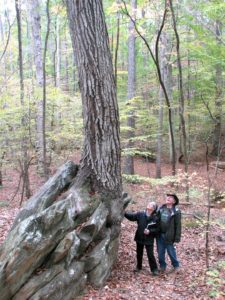
Several years ago our hiking group set out to visit a large forest park on the edge of our growing capital city of Raleigh. One of us wants to show the rest of us an amazing sight: a tall oak tree, seemingly growing out of solid rock. We marvel at it, examining it from all sides. We look closely at the roots. It is indeed difficult to tell rock from tree, they are so melded together. Which came first? Did tree push up rock or did rock lift up tree? It evokes in me a sense of wonder and mystery and a silent longing. I don’t tell the others what I’m thinking, that in other cultures this especially unique tree would surely be seen as sacred, as a sign of the action and presence of spirit.
Can we colonialist Americans ever regard nature as sacred, as ensouled, as imbued with spirit and meaning? If so we might cease destroying the Life we have been given, the living beings with whose well-being we have been entrusted, the Earth herself with whom we are meant to co-evolve consciousness and co-create beauty. Resacralizing our place on earth starts in our very particular, very local places, “where our feet are planted,” as Sharon Blackie says. I honor this Place of the Oak Rock by celebrating the wonder that this tree being evokes in me, and her potential for conveying wisdom and healing as I sit with her. I feel great grief that we are so disconnected from the spirit-filled land around us, and I think the pain is not only mine but also the pain of my European ancestors whose lands were also colonized and who arrived in a land from which any sacredness was stripped. David Abrams says, “We cannot restore the land without restorying the land.” I imagine that we might sit together under such a tree and tell each other the stories that she whispers to us. Later we might share these stories sitting around a fire with our neighbors, as communities have done for millennia to renew the bonds between themselves and their beloved homeland.
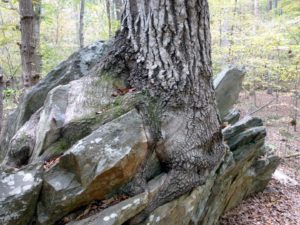
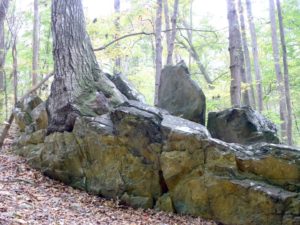
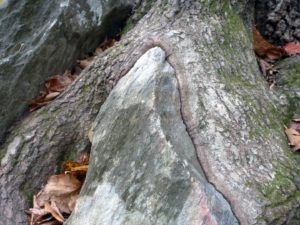
When I tell a friend about this rock-tree or tree-rock and the sadness I feel that we tend to just say, “oh wow,” at such a sight and walk away, she tells me that she once visited a tree growing out of rock that hangs over the edge of Lake Superior on the Minnesota border with Canada. She says it is called the Witch Tree and is regarded as sacred by the Ojibwe. It becomes my dream to visit this tree.
The Witch Tree
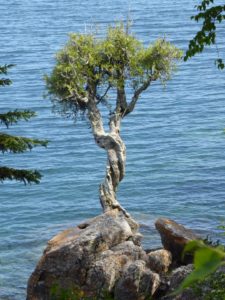
Now, three years later, we are on our way to see my husband’s cousins on the Lac Courte Oreilles Ojibwe reservation in northern Wisconsin for their Honor the Earth Powwow. (A story about visiting our Ojibwe relatives is here.) This time I am determined that we will make the four hour drive up along the Minnesota coast of Gitchi Gami to experience the Witch Tree. We gather together a cousin and another Ojibwe friend and arrange for a guide from the Grand Portage Band of Lake Superior Chippewa to take us to the tree. The tribe has built steps down the steep trail to it and an observation deck overlooking the tree in order to keep people from taking pieces of the wood. From our vantage point we can see that the twisted and stunted tree is growing precariously out of the bare rock of the cliff face on the edge of, on the day of our visit, calm blue water. But this enormous lake is notorious for its harsh storms. The tree has withstood the ferocious wind and waves and ice of three to four hundred Lake Superior winters. So it is revered as a teacher of fortitude in the face of adversity. John Morrin, a historian with the Grand Portage Reservation Tribal Council says, “It’s for all people who want to rejuvenate their spiritual path. It’s hard to walk that road, that straight road. And I think that’s what it’s trying to tell us, that it’s going to be very hard. You’ve really got to hold on to your sacred ways.” Ah, this is a story, a message for us all in these times.

I smile to see ribbons much like those in Ireland hanging, along with tobacco prayer ties, on the trees near the viewing platform. We strip off a piece of handkerchief and add a prayer for the health and well-being of our tribes. We pray to our deep-time Native American and Northern European ancestors that there may be healing between them, between us all. Our young guide tells us that after their powwow the following weekend the trees will be covered with colorful prayer ties. We pass around a pouch of tobacco and put down prayers of gratitude for this sacred tree.
The non-natives who first visited that tree named it “Witch.” Christians tended to translate something called Manitou, meaning Spirit, as Witch. Our guide tells us that, their language having been forced out of them, he grew up calling it Witch Tree, as do most of his tribe, although they are trying to get back to calling it by its real name, Manido Gizhigans, Spirit Little Cedar Tree. Indians are not allowed to own their reservation land; it is held in trust for them by the US government. If the tribe falls below a certain number of people, the land reverts to the government. The small Grand Portage band faces that possibility, so in 1987 they put out an appeal and received donations from people in forty states, Canada, Mexico, England, Holland, and the Soviet Union to purchase the off-reservation area of land surrounding the sacred tree.

Northern white cedars, Thuja occidentalis, are some of the oldest trees in eastern North America, second only to our bald cypresses. I am in love with Gizhik, Northern white cedars, not least because they are full of paradox and mystery, growing both out of bare, dry rock and also in wetlands called white cedar bogs. My father used to take me to the Atlantic white cedar bogs in the New Jersey Pine Barrens where he grew up, and I feel a sense of kinship and fascination with wetlands and their plant and animal species. My community likes to burn the dried needles of cedar, purifying ourselves in the fragrant smoke, so I wanted to bring a small supply back home with us. One day near the end of our Wisconsin trip my husband and I went to explore a wetland. We came upon white cedars growing along a creek. I wasn’t sure how to go about gathering some needles. I wavered between two extremes, struggling with starkly contrasting thoughts and feelings.
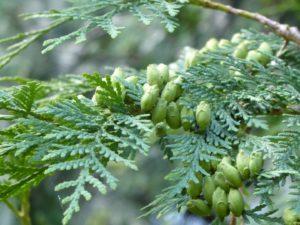
On the one hand I thought about how us white folks usually just go in and simply take whatever we want, feeling some unspoken right to do so. On the other I felt uncomfortable thinking of taking anything at all from the wild in this place that was not mine and a concern to leave these trees pristine, not deface them in any way. If I had grown up native, elders would have taught the protocol for how to gather each kind of plant from woods or wetlands respectfully. I would have to work this out on my own. No, I could ask the trees. They replied that we could take one small twig from each of a number of them, thanking them as we did so. This way no one tree would be unduly damaged. I shared with each tree the promise that we will be honoring them every time we burn their needles and smell their fragrant incense. Suddenly I sensed that the trees were happy that we were taking their leaves, that they wanted to give something of themselves to us. I was surprised to feel joyful coming off the trail, having taken something in a respectful manner with us from those trees. I felt a sweet intimacy with them, an even closer relationship to white cedar that will continue to grow throughout the year until we go back up north to visit our relatives again, our kin of the human and the tree kind, both revered as sacred. Gidinawendimin, We are all related.
Spirit Little Cedar Tree: https://www.naturalhistorymag.com/endpaper/302512/spirit-of-lake-superior
Text (c) 2019 Betty Lou Chaika. Photos (c) 2019 Betty Lou and David Chaika, except where noted. Photo of my husband and me with Oak Rock Tree is (C) Jerry Reynolds.
Sue-Anne Solem
Here I am in the land of the Redwood. It is also the land of the Monterey Pine and Cypress, and Douglas Fir, among many other trees. Today it is cold and foggy all day, just the right weather for the redwoods and their coastal cohorts. Last year, and the year before, when visiting this place, Arcata, in Northern California, there were several days of clear skies and sun, typical of more interior places but not the coast. Despite my glee in seeing the sun and feeling the warmth, I knew it was not right. This rainforest lives on the cool, foggy climate that is supposed to reign here. So, despite my yearning to be warm, I am glad for the fog all day, and the temperature not going above 70. That is as it should be.
Blessed be the trees, and all who live among them.
Betty Lou Chaika
Ah, Sue-Anne, I haven’t been to the Redwoods in way too long. Reading your experience evokes in me multi-sensual images of how particular forests feel to us and might feel to the trees themselves: enjoying brightness or darkness, warmth or coolness, moisture of rain or fog on the skin of leaf or flesh. Reminds me of the wonderful chapter on the Douglas Firs and Mother Cedar in the “Old-Growth Children” chapter of Braiding Sweetgrass.
riverdave
i really enjoyed this betty lou!
Betty Lou Chaika
RD, I might guess you would like reading this, you who take people into the forests and are the all-about-trees man!
Sue-Anne
And another thought: on a trip to Crete, a goddess pilgrimage, back in the 90’s, we visited an ancient nunnery where a thousand or so year old myrtle tree was hung with many ribbons of prayers and wishes, and we each put our own ribbons on the tree. Ahhh….
S
Betty Lou Chaika
Yes, it’s that world-wide impulse to venerate trees, and to share in the Life of those ancient, venerable Old Ones. Receiving healing from them and giving back gratitude makes us whole. What a delicious memory!
Barbara Janeway
That Witch Tree is a tai chi tree!
Betty Lou Chaika
Yes, Barb, it makes sense that a teacher of tai chi would see that the tree is doing tai chi, such is the feeling of its energy. Your observation is also interesting in that our guide told us that the tree was originally named “Witch Tree” from a painting in which the painter portrayed the trees as witches dancing.
Barbara
That is so very wonderful. I remember certain trees on the UNC Chapel Hill campus, near the Music dept.– that I used to go out and relate to, as they have long graceful arms doing their own tai chi so gracefully…..There is an energy of distinct movement in certain trees, energy flowing, that can enliven a person….
Betty Lou Chaika
Barb, thank you for bringing up this very important aspect of relating to tree beings. I had a profound experience of entering the field of energy between me and Hazel Tree, but I tend to forget to meet trees with that level of bodily openness and sensory awareness. An herbalist friend, Suki Roth, demonstrated beginning to approach a tree from a distance and stopping every few feet to experience the energy of the tree as you get closer and closer.
Betty Lou Chaika
And just this moment a friend sent a quote from Mary Oliver: “This is the first and wildest thing I know: that the soul exists and is built entirely out of attentiveness.”
Suz Robinson
I could sense the oneness of David, you and the trees. Heart warming post!
Betty Lou Chaika
Yes, Suz, I was thinking about that, too, how he was part of every one of those tree encounters. For that I am very grateful. And for your big heart!
Brian T Stokes
The depths of your Heart and Soul are so stunningly conveyed in your patient and rich word painting here.
Thank you for inspiring us to hold on to our sacred ways.
With humble gratitude and awe,
Brian
Betty Lou Chaika
Brian, I wish I could make a post about your heartfelt and soulful poetry and sculpture to inspire readers with your sacred ways of creating with and for nature.
Margot Ringenburg
Betty Lou, reading your latest post, Sacred Trees: Rag Tree, Rock Tree, Witch Tree, was a wonderful way to greet the day. Thank you.
Your memory of your grandmother’s sugar maple reminded me of something naturalist John Burroughs once wrote: “I always feel at home where the sugar maple grows . . . glorious in autumn, a fountain of coolness in summer, sugar in its veins, gold in its foliage, warmth in its fibers, and health in it the year round.”
Betty Lou Chaika
Margot, I so appreciate your work of educating young folks about our native plants and trees.
This quote, “sugar in its veins” reminds me how important the sugar maple camps were to the Ojibwe people, to their social structure, and to the seasonal gathering traditions that they are trying to keep alive. It indeed represents health on so many levels. There is a large sugar maple right outside my writing room that in autumn fills the room, and me, with golden light.
Ann Gayek
It is wonderful for me to read how you and others love trees as much as I do. I like your description of talking to the cedars and feeling their joy in sharing themselves with you. Is The Rock Tree in Umstead Park?
Betty Lou Chaika
Ann, it’s amazing how such a simple sign of respect as asking the cedars and listening to their answer made such a transformative difference in being with them and receiving their gifts.
Yes, The Rock Tree is in Umstead Park. Your interest makes me think of gathering a few folks and making a pilgrimage there to listen to him/her (oaks are both) and write or draw or dance the responses we receive.
Rebecca Tighe
Beautiful! I just finished The Overstory by Richard Powers. This was a lovely continuation of concern and reverence for these wonderful beings. We owe them such respect and gratitude.
Betty Lou Chaika
Hi Rebecca, I’m happy to celebrate with you these tree beings, who are to be honored in themselves and for their role as mediators between us and the spirit world. Thanks for reminding me, I must read The Overstory. I just heard Powers speak along with Terry Tempest Williams and Robin Kimmerer. What wonderful human and tree teachers we have!
Barbara
Yay! Yes….
Nancy Tusa
Betty Lou, thank you so much for sharing this beautiful story! I was immediately struck by the photo of the Old Growth Bald Cypress, which is very similar to an image in my dream last night. Swamps and the trees that dwell there have always held such mystery for me. It feels so natural to me that you would recognize that your beloved grandmother and the sugar maple were one and the same. I love the idea of re-storying trees by listening to the stories they whisper to us through the wind. It’s also very comforting to feel that wishing trees (and nature in general) over time can absorb and heal whatever ails our mind and bodies. Thank you for reminding us that trees are indeed sacred.
Betty Lou Chaika
Nancy, I’d love to hear your dream! One of my longings is for us to share our dreams of trees or wetlands or other aspects of the natural world, not just as personal messages, but as the Earth speaking to us through them. If you haven’t already seen it you might be interested in this post: Earth-Dreaming: Liminal Waters Dreaming is one of the ways we can re-story the land in which we live. Sadly, I think that by how we are disrespecting and abusing her we are sorely challenging nature’s ability (or desire to) absorb our problems and heal them. May we learn to love her again.
Barbara Janeway
Hi Nancy! I so enjoy your reply here. I have been re-reading these replies from people, and BL’s post. There is certainly so much wonderful and sacred about trees. I especially miss the great, tall trees back east. Here they are smaller, denser, tougher, more wiry, to survive the intense dryness…….But, still great and good to be around, especially old oaks……
Jill Over
Rocks and trees, trees and rocks, ahhh, thank you for sharing your stories and adventures. I do think that more books are being written about how to honor, respect, and connect with trees. The Overstory by Richard Powers is a wonderful book that touched my heart and soul. As a child, I grew up next to a woods that no doubt contributed to my love of trees and the natural world. My memories of being in the woods and along the creek are still vivid with a strong feeling of freedom. with much appreciation, jill
Betty Lou Chaika
Thanks for your comment, Jill. You officially win the prize for Most Supportive Friend of Earth Sanctuaries! . . . And more books are also being written about how important it is for children to get outside to experience trees and all of nature, so we can continue to have Earth lovers who honor as sacred the plant and animal communities and the landscapes in which we live.
Donna Deal
Loved this story, and all the replies. My first spiritual experience was at the age of 10, while sitting under a large tree at the top of a hill, overlooking our farm. It was a very special place, and the feeling has stayed with me all these years.
I wish you and David safe travels to the north, and I look forward to your next post!
Betty Lou Chaika
Donna, yours is a perfect example of how a childhood experience with a tree and with the land becomes a sustaining memory and a lifelong devotion to nature, to working with and for nature. I believe that you, our, care and tending and love for Earth is, in turn, helping to sustain her in these times when she is being so mistreated. Thank you for your encouragement to keep offering these stories about ways to love her!
Beverly Miller
Betty Lou, thank you for your appreciation of trees – – we are kindred spirits. I live in Raleigh now and sometimes walk at Umstead Park; however have never come across the rock tree. Perhaps it is off the beaten path. Please alert me if you or a group plan to experience the rock tree and I would love to join you.
Betty Lou Chaika
Hi Beverly, my sweet tree friend! Actually there is a path beaten to the tree. It is signed Oak-Rock Trail and is probably on Umstead Park Maps. I will definitely let you know when we visit Tree as a group. Your presence, communing with this amazing being would be lovely.
Sue-Anne Solem
It took me this long to read your comment, B-L! Goodness! And so today, going through emails in a way that I can stand, ie, sitting out in the sun on this glorious day in Fletcher, near Asheville, I find your email and comment. And I wind up re-reading your lovely missive. And I wind up with a beautiful image from my past, on the island of Crete: the ancient sacred myrtle tree at an ancient nunnery, bedecked with wishes written on slips of paper or pieces of cloth, from the pilgrims who visit.
It was there that I saw one of the icons that moved me to give myself my spirit name. The painting was hung over the threshold of the sanctuary, and, intrigued with it, I asked about it. I was told it was Anna giving birth to Mary. What had caught my attention was the three women at the lower right corner, one of whom was washing out a bloody rag. Of course, I saw them as the original three Minnie-Tonkas, so of course the painting would have relevance.
At that moment of awareness, I knew my spirit name would be Sofianna: a merging of the icon of Sophia I had resonance with, in a small sanctuary I had visited by myself by candlelight, and Anna, mother of Mary. The image of Sophia also had a threesome: three women, much small in size, at the base of Sophia’s image. I had thought, in each case, that the images were of Mary. My tour guide, Carol Christ, told me in the Sophia image the threesome were faith, hope and charity, and the large image was Sophia, not Mary.
Hence, my spirit name, my resonance with the “rag tree”, and my gratitude for your posts!
Love,
S
Betty Lou Chaika
Dear Sophia-Anna, Sofianna, named at the sanctuary of the Goddess on Crete, thank you for telling the origin of your beautiful spiritual name! Mother goddesses seem to frequently come in threes. I think of the pre-Christian Irish goddess Brigid who is depicted as three sisters in one, goddess of poetry, healing, and smith-craft. Researching the German grandmothers of my grandmothers I see a hundred images of the old sculpted stone figures called Matronae, “Triple Mothers,” always in threes, who followed and blessed their descendants. See painting at http://www.monicasjoo.co.uk/2014/03/30/matronae-triple-mothers/
Your telling about the inscribed paper or cloth prayers hanging on the tree at the nunnery on Crete reminds me of being at Brigid’s Garden near Galway and reading some of the writing on papers hanging from a grove of trees in the children’s garden. One poignant prayer, obviously from a traumatized child, asking for goodness, brought tears to my eyes.
Lawrence A Parent
What an incredible journey it is to read, as it must have been to experience. I have decided to comment, however, on one of the response comments you gave, where you and Sue-Anne, Sofianna, were speaking of women coming in threes. You know, BettyLou, of my connection to the thunderbirds, so you may recognize something of this vision I had many years ago. A storm was imminent and I had just smoked, and in that communion that followed the smoking the thunderbirds sent me a vision. I was looking to the west and saw clouds on the horizon,. Out of the mass of clouds came a separate cloud that seemed to have intent, as it felt as if the thunder could not be contained – they were angry. It would be a long story to tell why they were so angry, but you an imagine it had to do with human interference with the weather. In this vision that cloud came closer, and I saw that it was three clouds, and as it came closer still, I saw that it looked like an eagles talons, coming to bring destruction on humankind and their creations. As those talons came closer I also was feeling more than seeing the thunderbirds off to the side, and they felt proud and were smiling. They nudged me with “Be patient, little one, and watch.” Those talons came closer and I saw that they were three separate storm cloud, bur each talon had the face of a woman, and their eyes struck lightning as they came. I feared, for they were fearsome, that I was being told of storms coming my way, but the thunderbirds said, “These are our wives. Don’t worry, they are in the east land, not where you are.” The vision ended with that, and I looked out, and all was calm. In the next couple days, however, I watched on the internet as three hurricanes hit the east coast successively, one after the other, and I knew them for what they were. miisa’iw
Betty Lou Chaika
Boozhoo Lawrence! Thank you for telling us the story of your vision of the Thunderbirds, their wives and the hurricanes they told you would be coming. I see that miisa’iw in Ojibwemowin means something like “That’s it.” Is that a traditional ending for a story? I am reminded once again of other Visions you have told us. Having and valuing visions is such a Native gift. Once again I realize that receiving visions from the spirit world is not much developed or encouraged in the colonizer culture. Miigwetch